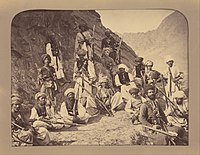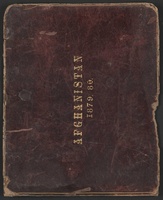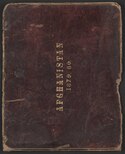John Burke (fotograf)
| John Burke (fotograf) | |
|---|---|
| Narození | 1843 Irsko |
| Úmrtí | 1900 (ve věku 56–57 let) |
| Povolání | fotoreportér, válečný fotograf a fotograf |
| Některá data mohou pocházet z datové položky. Chybí svobodný obrázek. | |

John Burke (asi 1843–1900) byl irský fotograf, nejznámější svými fotografiemi z druhé anglo-afghánské války mezi lety 1878 a 1880.
Životopis
Narodil se v Irsku kolem roku 1843, kde byl obchodníkem. Ucházel se o práci v britské armádě jako oficiální fotograf, pak ale na vlastní náklady cestoval do Afghánistánu[1][2] s vybavením několika těžkých fotoaparátů, které přes horské oblasti potřebovaly přepravu na zvířatech.[3] Burke byl prvním významným fotografem Afghánistánu. Zemřel v roce 1900.
Autorovy fotografie byly seskupeny v albech s fotografiemi Benjamina Simpsona a dalších fotografů, takže u některých jeho děl není možné definitivní přiřazení autorství.
Fotografie buddhistických ruin v Ali Masjid
Fotografie buddhistických ruin v Ali Masjid v průsmyku Khyber, zobrazující délku zdi pokryté výklenky s obrazy Buddhy, pořízená Johnem Burkem v roce 1878. Burke doprovázel polní síly v Peshawar Valley, jednu ze tří britských anglo-indických armádních kolon rozmístěných v druhá afghánská válka (1878-80), přestože byl odmítnut pro roli oficiálního fotografa. Svou cestu financoval předprodejem svých fotografií „ilustrujících postup z Attocku do Jellalabadu“. Burke přišel do Indie jako lékárník s Royal Engineers a stal se profesionálním fotografem a asistoval Williamu Bakerovi. Hodně cestovali po Indii a byli hlavními rivaly známějšího Bournea a Shepherda. Burkeho dvouletá afghánská expedice vytvořila důležitý obrazový dokument regionu. Islám se stal dominantním náboženstvím Afghánistánu v 10. století; mešita Ali Masjid v průsmyku Khyber je spojena s Hazratem Alim, prorokovým zetěm a čtvrtým chalífou islámu, který se prý na tomto místě modlil. Region je však posetý pozůstatky předislámské minulosti Afghánistánu; starověká historie země sahá od předzoroastriánských kultů až po zoroastrismus a buddhismus a poté hinduismus. Buddhismus byl propagován v Afghánistánu císařem Ashoka ve 3. století před naším letopočtem a v 1. století před naším letopočtem byl dominantním náboženstvím v této oblasti. Za vlády buddhistických Kushanas (středoasijské dynastie, která vládla částem Afghánistánu a Indii v 1. až 3. století našeho letopočtu), došlo v Afghánistánu k velkému vývoji architektury a sochařství. Bylo to formativní období pro obraz Buddhy a buddhistickou stúpu. Postupující britská armáda narazila na řadu buddhistických ruin a Burkeho fotografie zahrnují mnoho archeologických nalezišť. V té době se o buddhistické historii subkontinentu vědělo jen málo a jedním z nezamýšlených výsledků kampaně byl nárůst zájmu o tuto oblast.
Galerie
- Pierre Louis Napoleon Cavagnari se Sirdary, konec 70. let 19. století
- Warburton s Naurozem Khanem z Lalpura Mohmands
- Následky bitvy u Ali Masjid, 1878
- Elephant Battery during the Second Anglo-Afghan War
- "Nautch girls, Kábul", 1879-1880
- Bitva u Ali Masjid: 24 captured large Afghan guns
- Afghanistan, album s fotografiemi Benjamina Simpsona, Johna Burkeho a dalších
- Fotografie buddhistických ruin v Ali Masjid v průsmyku Khyber, Rádžasthán, Indie
Odkazy
Reference
V tomto článku byl použit překlad textu z článku John Burke (photographer) na anglické Wikipedii.
- ↑ MACDONALD, Kerri. A Collaboration Across 130 Years. The New York Times. Dostupné online [cit. 1 June 2015]. (anglicky)
- ↑ MUTHIAH, S. The photographer who came here. The Hindu. 25 November 2002. Dostupné v archivu pořízeném z originálu dne 12 March 2003. (anglicky)
- ↑ In Conversation: Paul Lowe and Simon Norfolk [online]. Simon Norfolk [cit. 2015-10-04]. Dostupné online. (anglicky)
Související články
Externí odkazy
 Obrázky, zvuky či videa k tématu John Burke (fotograf) na Wikimedia Commons
Obrázky, zvuky či videa k tématu John Burke (fotograf) na Wikimedia Commons
Média použitá na této stránce
"Buddhist Temple excavated at Ali Musjid" [*Burke 1878c*]
The aftermath of the Battle of Ali Masjid
Sir Pierre Louis Napoleon Cavagnari with the Sirdars, by John Burke (died 1905). See source website for additional information.
Sir Pierre Louis Napoleon Cavagnari with Sardars and Nasher Khan, seated on the left.
This set of images was gathered by User:Dcoetzee from the National Portrait Gallery, London website using a special tool. All images in this batch have been confirmed as author died before 1939 according to the official death date listed by the NPG.Close view of façade of Stupa No.5, with Buddha statues in niches, at Ali Masjid
- "Nautch girls [Kabul]," a photo by John Burke, c.1879-80* (BL) [*Burke 1879a*];
This photograph is from an album of rare historical photographs depicting people and places associated with the Second Anglo-Afghan War. Elephants were commonly used as shock cavalry in the front lines of military campaigns throughout South and Southeast Asia until the end of the 19th century, when the introduction of advanced artillery and Gatling guns made them vulnerable to enemy fire. The British Indian Army, like their Mughal imperial predecessors, used war elephants to transport large quantities of cargo, but the main advantage of the elephant in late-19th-century military tactics was in towing heavy field guns that horses and mules could not manage. In this photograph, the lead elephants in each team are mounted by Indian mahouts and escorted by British cavalry and foot soldiers. An accompanying baggage train of mules and oxen is seen on the right. The Second Anglo-Afghan War began in November 1878 when Great Britain, fearful of what it saw as growing Russian influence in Afghanistan, invaded the country from British India. The first phase of the war ended in May 1879 with the Treaty of Gandamak, which permitted the Afghans to maintain internal sovereignty but forced them to cede control over their foreign policy to the British. Fighting resumed in September 1879 after an anti-British uprising in Kabul, and finally concluded in September 1880 with the decisive Battle of Kandahar. The album includes portraits of British and Afghan leaders and military personnel, portraits of ordinary Afghan people, and depictions of British military camps and activities, structures, landscapes, and cities and towns. The sites shown are all located within the borders of present-day Afghanistan or Pakistan (a part of British India at the time). About a third of the photographs were taken by John Burke (circa 1843–1900), another third by Sir Benjamin Simpson (1831–1923), and the remainder by several other photographers. Some of the photographs are unattributed. The album possibly was compiled by a member of the British Indian government, but this has not been confirmed. How it came to the Library of Congress is not known.
Afghan Wars; Cavalry; Elephants; Great Britain. Army; India. Army; Mountains; Soldiers
Afghanistan, 1879-80 is an album of rare historical photographs depicting people and places associated with the Second Anglo-Afghan War (1878–80). The war began in November 1878 when Great Britain, fearful of what it saw as growing Russian influence in Afghanistan, invaded the country from British India. The first phase of the war ended in May 1879 with the Treaty of Gandamak, which permitted the Afghans to maintain internal sovereignty but forced them to cede control over their foreign policy to the British. Fighting resumed in September 1879 after an anti-British uprising in Kabul, and finally concluded in September 1880 with the decisive Battle of Kandahar. The album <a name="_GoBack"></a>includes portraits of British and Afghan leaders and military personnel; portraits of ordinary Afghan people; depictions of British military camps and activities; and Afghan structures, landscapes, and cities and towns. The sites shown are all located within the borders of present-day Afghanistan or Pakistan (a part of British India at the time). About a third of the photographs were taken by John Burke (circa 1843–1900), another third by Sir Benjamin Simpson (1831–1923), and the remainder by several other photographers. Some of the photographs are unattributed. The album possibly was compiled by a member of the British Indian government, but this has not been confirmed. How it came to the Library of Congress is not known.
Afghan Wars; Cities and towns; Forts and fortifications; Government officials; Great Britain. Army; India. Army; Military camps; Military officers; Pushtuns; Sikhs; Soldiers; Street scenes
The aftermath of the Battle of Ali Masjid
















